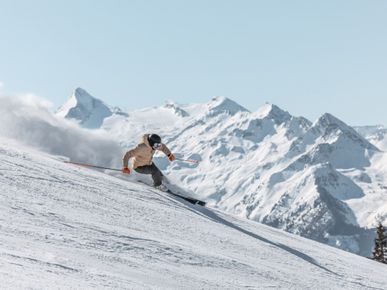THE WHITE ANGELS
Avalanche course with Bründl Sports
When fun gets serious, it’s professional help that counts. Markus Amon is an experienced air rescuer and a true expert regarding the mountains. He runs the annual avalanche course at Bründl. A review.

In the world of mountain rescue, there is a time window of 15 minutes. A quarter of an hour, and after that, the chances dwindle of recovering somebody alive from an avalanche. 15 minutes go quickly, you just have to read the long version of Markus Amon’s CV. The short version goes like this: qualified nurse, paramedic, mountain and ski guide, Army mountain guide and Army air rescuer, mountain rescuer, air rescuer, now HCM Operation Manager, i.e. executive air rescuer of Christophorus Flugrettung. Under “Miscellaneous”: high-altitude mountaineer and extreme skier.
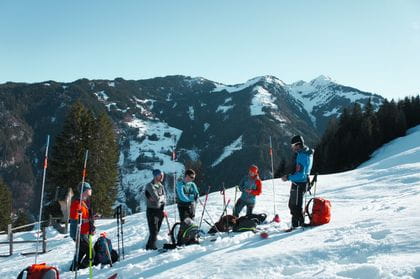
The climb to the avalanche course
You can’t separate the one from the other. Markus Amon’s life is played ou tin the borderline area between life and death. It delivers the material for multimedia presentations and the model for a James Bond film. He has the steel-blue eyes of a Daniel Craig, even if Amon says that the operations on the helicopter cable are part of hard, everyday working life. Together with his colleagues from the Kaprun mountain rescue service, Markus also led our customers into the world of avalanche awareness this year with three avalanche seminars. The theory at the flagshipstore was followed by the exercise part in the field - this year, in Kaprun on the Kitzsteinhorn and on the Biberg in Saalfelden. It is about behaviour after an avalanche, about equipment, team spirit and the time factor; in short,about decision-making strategies in an emergency.
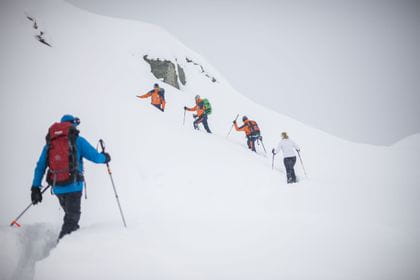
Who could be better suited for the courses than Amon? In his free time, he is a talking point time and again with solo-speed ascents of eight-thousanders (such as on theultratrailup Mount Everest). At home in Austria, he and his colleagues are something like the white angels for snowboarders, skiers, freeridersand ski tourers. If someone loses their way, injures himself/herself in rough terrain or is trapped by an avalanche, the mountain rescue sends the helicopter–with men like Amon. Amon himself is not allowed to fly, but he abseils down to the scene of the accident hanging on a rope, to carry out first aid and the evacuation to a safe location. He is the pilot’s extended eye.
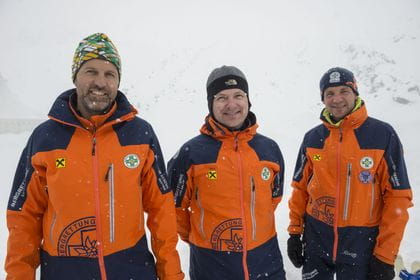
In the hostile environment of the Himalayas, where acclimatisation and adaptation give the body enough to cope with, and every assistance could endanger your own life, it’s every man for himself. Closer to home, however, the success of an operation depends to a large extent on the reaction of your workmates.
Amon says: “It’s like cooking. It’s only with the right ingredients that you can achieve the optimum result.” Fred adds: “The only thing that really helps iscomradeship.” And, of course, the indispensable tools: an avalanche probe, a shovel and an avalanche transceiver. Thomas calls them “the holy three”

The trio at Langwiedboden have now set up a typical scenario. It shows how to locate an avalanche victim, to pinpoint him/her with the probe, which is up to four metres long, and digital detectors –to then be able to carefully dig the victim free. No movement is arbitrary. Every detail can save a life. Are the mouth and nostrils clear, does the patient have an air pocket so that he/she does not suffocate? Is the avalanche transceiver sending interference signals that are making the search more difficult?
Or are there even indications such as a ski pole sticking out of the snow cover, which can lead directly to the avalanche victim. And finally: Are the head and spine stable, is a place sheltered from the wind available? If the patient cannot be evacuated on the akia, or rescue toboggan, Amon attaches the chest belt or rescue bag to him/her. This allows the patient to be evacuated in the helicopter, either seated or lying down. “Every movement must be spot on”, Amon says, including, and especially with gloves.
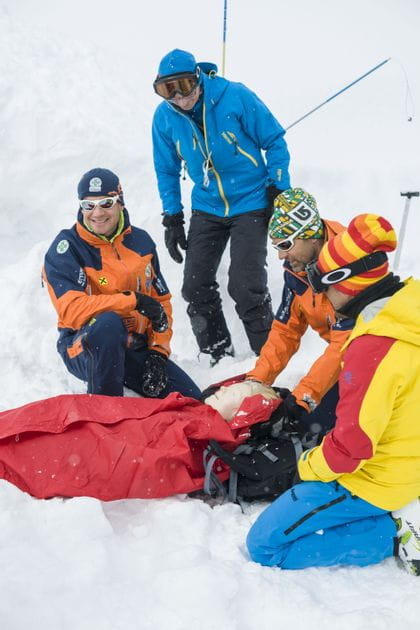
Practice makes perfect
As an amateur, you might ask how that should be achieved when push comes to shove. When only a few minutes remain, and your colleagues are poking around with the probe in the snow like with a pole in fog. On the other hand, these are absolute professionals at work here. The helicopter is in the air in three minutes, and the procedure from the emergency call to the evacuation has become second nature to the men in countless hours of exercises. Apart from that, and the participants in the two-day avalanche course were also taught this, good tour preparation has a great deal to do with careful planning, the right choice of route and terrain and the ability to interpret the weather conditions and snow conditions correctly. Over 200 people came to listen to Markus Amon and his team at the Bründl event.
With the help ofs ponsors like Bründl,Amon sets off time and again to climb the highest mountains in the world; most recently, the Mountain of the Soul in the Nepalese part of the Himalayas. On the trail of his role model Peter Wörgötter, also from the Pinzgau region, Amon descended from the peak of Manaslu to the base camp on skis, after a record ascent. Single-handedly and without oxygen bottles or sherpas, of course. It might be little comfort to a ski tourer who ends up in a difficult situation in the Alps. But if there is someone like Markus Amon participating in the operation, who is able to keep his head even in extremely high-altitude air, that is a good omen, at least.
